2.3. Complex Queries¶
Simple SQL queries are commands that perform straightforward data retrieval,
usually from only one table at a time. Examples of these queries include using
the SELECT and WHERE keywords, and they narrow the result set by
focusing on a single parameter.
Example
1 2 3 | SELECT *
FROM movies
WHERE release_date >= 2015;
|
Note that in line 1, we selected all of the fields in the movies table,
but we could easily replace * with a smaller set of column names.
Complex SQL queries go beyond the standard requests by retrieving data from several tables and by limiting the result set with multiple conditions.
In the previous chapter, you learned how to use joins to display data that is spread over different tables. Another advanced SQL tool is called a subquery, which is a simple SQL command embedded within another query. By nesting queries, you can set up larger restrictions on the data included in the result set.
Complex queries often combine joins and subqueries, and they may also include
multiple AND/OR operators within the WHERE clause.
2.3.1. Review Joins¶
Code along with the following examples using the storage database and
tables you created earlier.
2.3.1.1. Inner Join¶
Each record in writing_supply stores a utensil_type value. We could use
a simple query to filter the records by type, but this would not contain data
such as quantity, which is stored in a different table.
To return a result set that contains information that appears in both the
writing_supply and pencil_drawer tables, we use an INNER JOIN.
Example
1 2 3 | SELECT *
FROM writing_supply
INNER JOIN pencil_drawer ON writing_supply.supply_id = pencil_drawer.supply_id;
|
The result set contains all of the records from both tables that have matching
supply_id values.
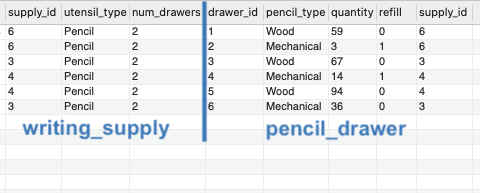
We could accomplish the same result using a series of simple queries, but
this would be inefficient. We would need to first run a query on
writing_supply and then use the results to shape one or more queries on
pencil_drawer.
To reduce the size of the result set, we can request specific fields and add conditions to the query:
Example
1 2 3 4 | SELECT writing_supply.supply_id, pencil_type, drawer_id, quantity
FROM writing_supply
INNER JOIN pencil_drawer ON writing_supply.supply_id = pencil_drawer.supply_id
WHERE refill = true AND pencil_type = "Mechanical";
|
Result Set

Note that in line 1, we need to specify the source for supply_id, since
both tables contain a column with that name.
2.3.1.2. Left/Right Join¶
We can use a LEFT or RIGHT join to retain all of the records from one
table and pull in overlapping data from another.
Example
1 2 3 | SELECT writing_supply.supply_id, utensil_type, drawer_id, color
FROM writing_supply
LEFT JOIN pen_drawer ON writing_supply.supply_id = pen_drawer.supply_id;
|
The result set contains null values for any rows that involve pencils. The
left join retains all of the data in writing_supply, but it can only
combine that information with data from pen_drawer if the rows share
supply_id values.
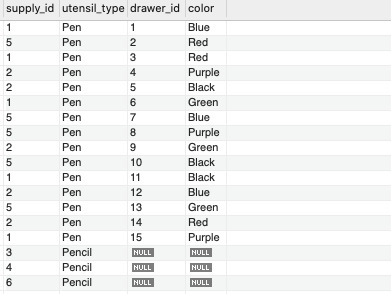
As with inner joins, we can restrict the size of the result set by adding one or more conditions:
Example
1 2 3 4 | SELECT writing_supply.supply_id, utensil_type, drawer_id, color, quantity
FROM writing_supply
LEFT JOIN pen_drawer ON writing_supply.supply_id = pen_drawer.supply_id
WHERE refill = true;
|
Result Set

2.3.1.3. Multiple Joins¶
The UNION keyword allows us to combine the results of separate SELECT
commands. Run each of the following queries individually and examine the two
result sets. Next, run the queries with UNION.
Example
1 2 3 4 5 6 7 8 9 10 | SELECT writing_supply.supply_id, utensil_type, drawer_id, quantity FROM writing_supply
LEFT JOIN pencil_drawer ON writing_supply.supply_id = pencil_drawer.supply_id
WHERE refill = true
UNION
SELECT writing_supply.supply_id, utensil_type, drawer_id, quantity FROM writing_supply
RIGHT JOIN pen_drawer ON writing_supply.supply_id = pen_drawer.supply_id
WHERE refill = true
ORDER BY supply_id;
|
Result Set
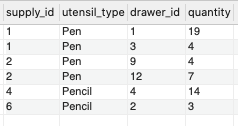
Lines 1 - 3 merge data from pencil_drawer into writing_supply, so long
as the rows have matching supply_id values and have refill set as
true. Lines 7 - 10 merge data from writing_supply into pen_drawer
with the same conditions. The UNION command combines the two result sets.
Note
Recall that MySQL has no FULL OUTER JOIN syntax. If we want to combine
all of the data from two separate tables, we must use the UNION
keyword between LEFT JOIN and RIGHT JOIN queries.
2.3.2. Subqueries¶
Consider the following situations:
- Retrieve the
supply_idvalues for anywriting_supplycontainers that hold pens. - Using the
supply_idvalues, retrieve the ID andcolorvalues for any drawers in the last container that hold 60 or more pens.
We can accomplish these actions by using two simple SQL queries:
Example
1 2 3 4 5 6 | SELECT supply_id FROM writing_supply
WHERE utensil_type = "Pen";
/* First result set contains the supply_id values 1, 2, and 5. */
SELECT drawer_id, color FROM pen_drawer
WHERE quantity >= 60 AND supply_id = 5;
|
Second Result Set

To complete the second SQL query, we must examine the result set from the
first, then hard-code the largest supply_id value into the line 6.
This is inefficient.
By using a subquery, we can combine the two SQL commands to accomplish the same
result. Let’s begin by embedding one simple SQL command inside the WHERE
clause of a second.
Example
1 2 | SELECT drawer_id, color FROM pen_drawer
WHERE supply_id IN (SELECT supply_id FROM writing_supply WHERE utensil_type = "Pen");
|
Result Set
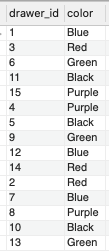
Items to note:
- An embedded inner query will always execute before the outer
query. In this case, the
SELECTstatement in line 2 runs first, followed by theSELECTstatement in line 1. - The inner query in line 2 creates a result set of
supply_idvalues from thewriting_supplytable, based on the conditionutensil_type = "Pen". - The outer query returns a result set of
drawer_idandcolorvalues from thepen_drawertable. - The condition
WHERE supply_id INchecks if thesupply_idvalue for apen_drawerrow matches one of thesupply_idvalues returned from the inner query.
The result set from this complex SQL command is not yet what we want, since it
returns values for ALL drawers in ALL of the pen supply containers. Let’s
modify the query by adding the condition for quantity.
Example
1 2 3 | SELECT drawer_id, color FROM pen_drawer
WHERE supply_id IN (SELECT supply_id FROM writing_supply WHERE utensil_type = "Pen")
AND quantity >= 60;
|
Result Set
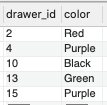
Now the result set shows only the information for pen drawers with 60 or more
items. This is good but still not quite complete, since we only want data from
the last writing_supply row that contains pens. To fix this, we need to
restrict the inner query to that single supply_id value.
The last pen container in writing_supply will have the largest value for
supply_id. Fortunately, SQL has a defined function, MAX(column_name),
that returns the largest value in the specified column.
Example
1 2 3 | SELECT drawer_id, color FROM pen_drawer
WHERE supply_id = (SELECT MAX(supply_id) FROM writing_supply WHERE utensil_type = "Pen")
AND quantity >= 60;
|
Result Set

Success! Our complex SQL query now produces the same result as the two
separate, simple SQL queries. However, using a subquery is more flexible, since
it does not rely on hard-coded values. We can see this benefit if we add 100
more entries to writing_supply. The original pair of queries still checks
for entries with supply_id = 5, even though this may no longer be the last
pen container. The complex query correctly identifies the last pen container
regardless of how many entries writing_supply contains.
2.3.2.1. Where Else Can We Add Subqueries?¶
In the examples above, you added one subquery into the WHERE clause of
another SQL command. However, it is also possible to place a subquery in the
FROM clause. Instead of pulling values from an entire table, this
setup retrieves data from the result set of the inner query.
Subqueries can be used with INSERT, UPDATE, and DELETE commands,
and it is also possible to place subqueries inside subqueries. We will not go
over these options here, but the links below provide some examples if you wish
to explore the topics on your own:
2.3.2.2. Last Reminders¶
- In most cases, subqueries should be enclosed in parentheses
(). - If a subquery returns multiple rows in its result set, using the comparison
operators (
=,>,<=, etc.) in aWHEREclause throws an error. In these cases, useANY,ALL, orINto check the condition across all of the rows. - In a
WHEREclause, a subquery must be placed on the right hand side of the comparison operator (ANY,IN,=,>, etc.)
2.3.3. Check Your Understanding¶
Question
UNION and JOIN produce the same result set.
- True
- False
Question
A subquery and a UNION accomplish the same thing.
- True
- False
Question
What is the execution order for the following complex SQL query?
1 2 3 4 | SELECT column_1 FROM table_1
WHERE column_1 IN (SELECT column_2 FROM table_2
WHERE column_2 IN (SELECT column_3 FROM table_3
WHERE num_items > 30));
|
SELECT column_1, thenSELECT column_2, thenSELECT column_3SELECT column_1, thenSELECT column_3, thenSELECT column_2SELECT column_2, thenSELECT column_1, thenSELECT column_3SELECT column_2, thenSELECT column_3, thenSELECT column_1SELECT column_3, thenSELECT column_1, thenSELECT column_2SELECT column_3, thenSELECT column_2, thenSELECT column_1
